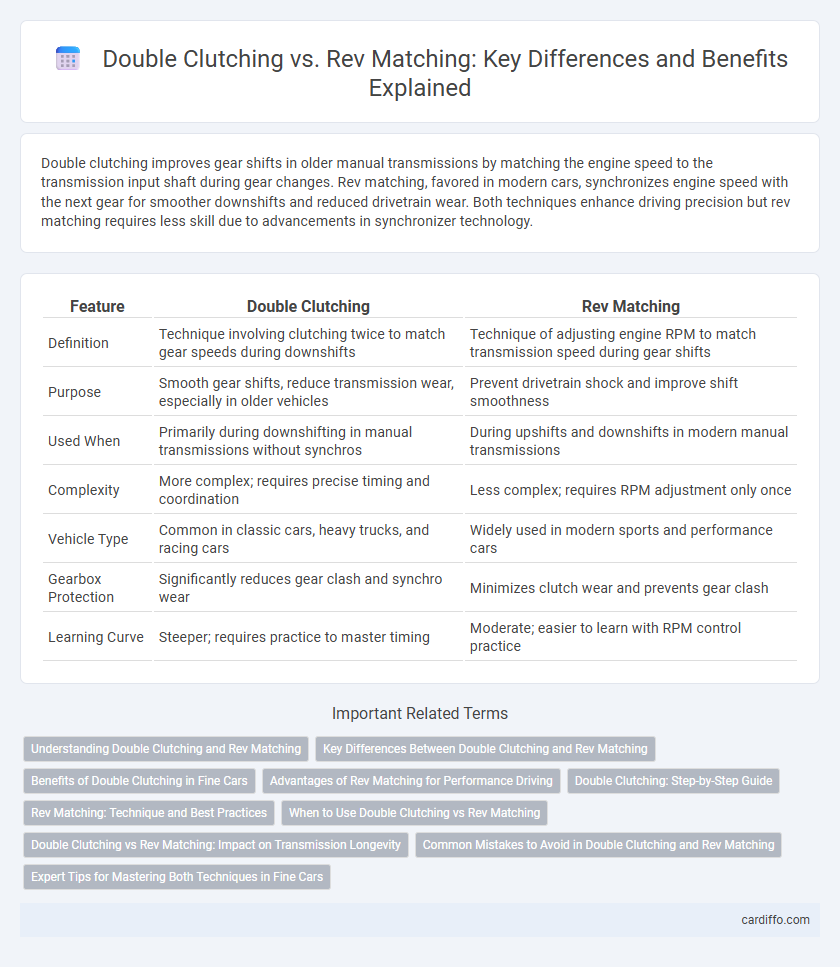Double clutching improves gear shifts in older manual transmissions by matching the engine speed to the transmission input shaft during gear changes. Rev matching, favored in modern cars, synchronizes engine speed with the next gear for smoother downshifts and reduced drivetrain wear. Both techniques enhance driving precision but rev matching requires less skill due to advancements in synchronizer technology.
Table of Comparison
| Feature | Double Clutching | Rev Matching |
|---|---|---|
| Definition | Technique involving clutching twice to match gear speeds during downshifts | Technique of adjusting engine RPM to match transmission speed during gear shifts |
| Purpose | Smooth gear shifts, reduce transmission wear, especially in older vehicles | Prevent drivetrain shock and improve shift smoothness |
| Used When | Primarily during downshifting in manual transmissions without synchros | During upshifts and downshifts in modern manual transmissions |
| Complexity | More complex; requires precise timing and coordination | Less complex; requires RPM adjustment only once |
| Vehicle Type | Common in classic cars, heavy trucks, and racing cars | Widely used in modern sports and performance cars |
| Gearbox Protection | Significantly reduces gear clash and synchro wear | Minimizes clutch wear and prevents gear clash |
| Learning Curve | Steeper; requires practice to master timing | Moderate; easier to learn with RPM control practice |
Understanding Double Clutching and Rev Matching
Double clutching involves shifting gears by first disengaging the clutch to move the transmission into neutral, then releasing the clutch to spin the input shaft to the appropriate speed before re-engaging the clutch into the target gear. Rev matching synchronizes engine speed with the transmission input shaft during downshifts to ensure smooth gear engagement without jerks or wear. Both techniques enhance driving performance by reducing drivetrain stress, with rev matching offering a more seamless approach for modern synchronized transmissions.
Key Differences Between Double Clutching and Rev Matching
Double clutching involves pressing the clutch twice during gear shifts to match the transmission speed, while rev matching focuses on adjusting engine RPM to synchronize wheel speed. Double clutching is primarily used in older vehicles lacking synchronization, whereas rev matching is common in modern manual transmissions to ensure smooth downshifts. Key differences include the complexity of execution and the necessity, with rev matching being more straightforward and suitable for everyday driving.
Benefits of Double Clutching in Fine Cars
Double clutching in fine cars enhances transmission longevity by reducing gear synchronizer wear and minimizing drivetrain shock during gear changes. This technique enables smoother shifts and improved control over engine speed, leading to better fuel efficiency and less mechanical stress. By mastering double clutching, drivers can preserve the vehicle's performance and maintain optimal driving dynamics in high-end automobiles.
Advantages of Rev Matching for Performance Driving
Rev matching enhances performance driving by ensuring smoother and quicker gear shifts, reducing drivetrain shock and maintaining vehicle balance during aggressive maneuvers. This technique allows drivers to match engine speed with transmission speed precisely, resulting in improved throttle response and better control over the car in high-speed cornering or track conditions. Efficient rev matching also minimizes wear on the clutch and transmission components, extending the lifespan of the vehicle while optimizing shifting performance.
Double Clutching: Step-by-Step Guide
Double clutching involves pressing the clutch pedal twice to shift gears smoothly, first to disengage the current gear and then to engage the next gear. This technique requires matching the engine speed to the transmission input shaft speed by adjusting throttle during the intermediate neutral phase. Mastering double clutching improves gear synchronization in manual transmissions, reducing wear and ensuring smoother shifts.
Rev Matching: Technique and Best Practices
Rev matching is a driving technique that involves adjusting the engine speed to match the transmission's gear speed during downshifting, preventing drivetrain shock and ensuring smoother gear transitions. Proper execution requires blipping the throttle just before engaging the lower gear, which reduces wear on the clutch and synchronizers while enhancing vehicle control and stability. Mastering this method improves performance driving, especially in manual transmissions, by maintaining engine and wheel speed harmony.
When to Use Double Clutching vs Rev Matching
Double clutching is essential when driving older vehicles with non-synchronized manual transmissions and during downshifts to smoothly match gear speeds without causing damage. Rev matching is most effective in modern manual transmissions for seamless gear changes and maintaining vehicle stability under acceleration or deceleration. Use double clutching primarily for vintage cars and heavy trucks, while rev matching suits performance driving and everyday manual shifting for smoother transitions.
Double Clutching vs Rev Matching: Impact on Transmission Longevity
Double clutching reduces wear on the transmission's synchronizers by matching input shaft speed through a neutral gearshift, minimizing shock and grinding. Rev matching achieves similar engine speed alignment by blipping the throttle during downshifts, which smooths gear engagement and extends synchronizer life. Both techniques enhance transmission longevity, but double clutching offers superior protection for older or non-synchronized gearboxes.
Common Mistakes to Avoid in Double Clutching and Rev Matching
Common mistakes to avoid in double clutching include improper timing between gear shifts and failing to match engine speed accurately, which can cause transmission wear and jerky shifts. In rev matching, avoid over-revving or abrupt throttle changes that lead to clutch slippage or abrupt downshifts. Mastering smooth synchronization of clutch release and throttle input is crucial to protect the drivetrain and ensure seamless gear transitions.
Expert Tips for Mastering Both Techniques in Fine Cars
Mastering double clutching and rev matching in fine cars enhances gear transitions, reduces drivetrain wear, and improves overall driving precision. Experts recommend practicing smooth clutch releases and precise throttle control to synchronize engine speed with transmission input shaft speed effectively. Regularly training on varied gear shifts builds muscle memory, allowing seamless execution and optimal performance in high-end vehicles.
Double clutching vs Rev matching Infographic

 cardiffo.com
cardiffo.com